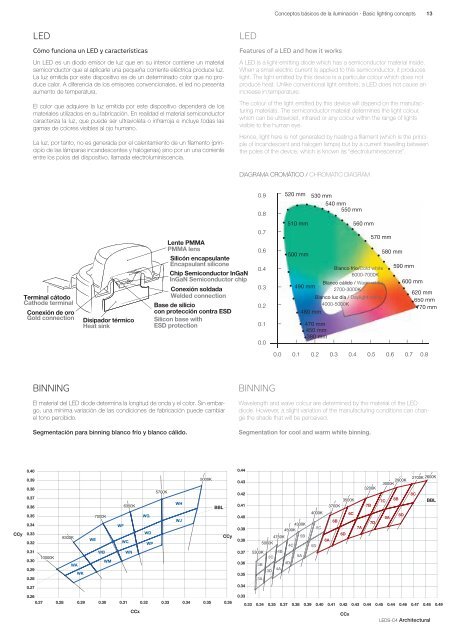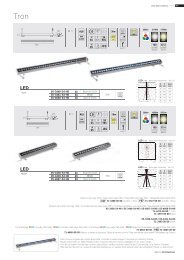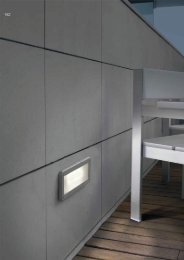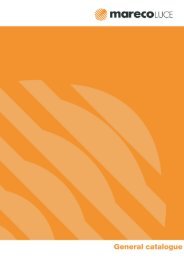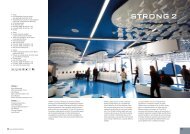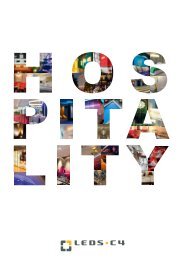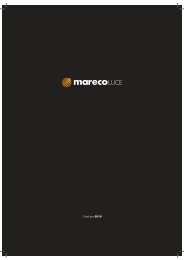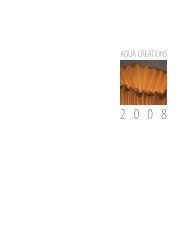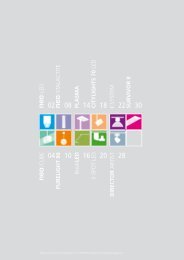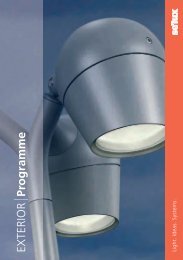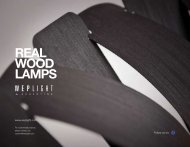Architectural - Light Vision
Architectural - Light Vision
Architectural - Light Vision
- No tags were found...
You also want an ePaper? Increase the reach of your titles
YUMPU automatically turns print PDFs into web optimized ePapers that Google loves.
Conceptos básicos de la iluminación · Basic lighting concepts13LEDCómo funciona un LED y característicasUn LED es un diodo emisor de luz que en su interior contiene un materialsemiconductor que al aplicarle una pequeña corriente eléctrica produce luz.La luz emitida por este dispositivo es de un determinado color que no producecalor. A diferencia de los emisores convencionales, el led no presentaaumento de temperatura.El color que adquiere la luz emitida por este dispositivo dependerá de losmateriales utilizados en su fabricación. En realidad el material semiconductorcaracteriza la luz, que puede ser ultravioleta o infrarroja e incluye todas lasgamas de colores visibles al ojo humano.La luz, por tanto, no es generada por el calentamiento de un fi lamento (principiode las lámparas incandescentes y halógenas) sino por un una corrienteentre los polos del dispositivo, llamada electroluminiscencia.LEDFeatures of a LED and how it worksA LED is a light-emitting diode which has a semiconductor material inside.When a small electric current is applied to this semiconductor, it produceslight. The light emitted by this device is a particular colour which does notproduce heat. Unlike conventional light emitters, a LED does not cause anincrease in temperature.The colour of the light emitted by this device will depend on the manufacturingmaterials. The semiconductor material determines the light colour,which can be ultraviolet, infrared or any colour within the range of lightsvisible to the human eye.Hence, light here is not generated by heating a fi lament (which is the principleof incandescent and halogen lamps) but by a current travelling betweenthe poles of the device, which is known as “electroluminescence”.DIAGRAMA CROMÁTICO / CHROMATIC DIAGRAMTerminal cátodoCathode terminalConexión de oroGold connectionBINNINGDisipador térmicoHeat sinkLente PMMAPMMA lensEl material del LED diode determina la longitud de onda y el color. Sin embargo,una mínima variación de las condiciones de fabricación puede cambiarel tono percibido.Segmentación para binning blanco frío y blanco cálido.Silicón encapsulanteEncapsulant siliconeChip Semiconductor InGaNInGaN Semiconductor chipConexión soldadaWelded connectionBase de siliciocon protección contra ESDSilicon base withESD protection0.90.80.70.60.40.30.2520 mm510 mm500 mm0.400.390.10.380.370.00.360.350.0 0.1 7000K 0.20.34CCy 0.338300KWE0.320.31 BINNINGWB10000K0.30WM0.290.280.270.260.27 0.28 0.29 0.30530 mm540 mm550 mmBlanco frío/Cold white6000-7000KBlanco cálido / Warm white490 mm2700-3000KBlanco luz día / Daylight white4000-5000K480 mm470 mm450 mm380 mm6350K0.3560 mmWavelength and WA wave colour are determined by the material of the LEDdiode. However, a slight variation of the manufacturing conditions can changethe shade that will beWKperceived.0.4Segmentation for cool and warm white binning.WFWCWNWGWD0.31 0.32CCxWP570 mm5700K0.50.33580 mmWH0.6WJ590 mm0.34600 mm620 mm650 mm770 mm0.75000K0.35BBL0.80.36CCy0.400.390.380.370.360.350.340.330.320.310.300.290.2810000K8300KWAWK7000KWEWBWM6350KWFWCWN5700KWGWDWPWHWJ5000KBBLCCy0.440.430.420.410.400.390.380.370.360.355300K3B3A5000K3C3D4750K4B4A4300K4500K4D4C5A5B4000K5D5C6A3500K3700K6B6D6C7A3200K7B7D2900K3000K7C8A8B8D2700K 2600K8CBBL0.270.340.260.270.280.290.300.310.32CCx0.330.340.350.360.330.330.340.350.370.380.390.400.410.42 0.43CCx0.44 0.45 0.44 0.46 0.47 0.48 0.49LEDS-C4 <strong>Architectural</strong>0.442700K 2600K


